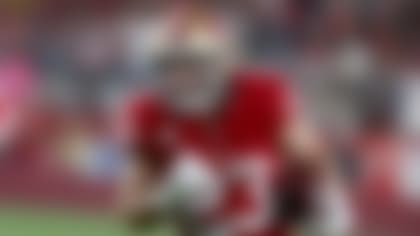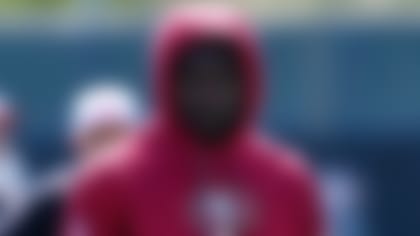The offseason is nearly over, and I'm way behind on all of my offseason lists. My stack of books to read is almost as tall as me, I've been neglecting the theater (though you should neglect to see "X-Men: Apocalypse," because it's bad), and my DVR is a crowded disaster at the moment. On top of that, I've barely scratched the surface of my offseason fantasy research.
To get the ball rolling, I wanted to look at red zone efficiency and play-calling for each team in the NFL over the last four years. Here's a quick overview of my findings before we get into the team-by-team breakdowns.
On average, NFL teams ran 132 plays in the red zone and converted just over 20 percent of said plays into touchdowns, for a league average of about 26 red zone touchdowns per team. Overall, there was a .595 correlation between red zone touchdown percentage and offensive scoring, which should come as no surprise to most football fans. Scoring touchdowns as opposed to field goals in the red zone will lead to more points, but there are obvious outliers such as big plays and long touchdowns. A .595 correlation isn't outrageous by any means (if it had been 0.7 or higher we'd really be in business), but it's positive enough to draw the rather obvious conclusion that it'd behoove us to lean toward drafting players who could have increased opportunities in the red zone in more efficient offenses.
Now, let's dive into the team-by-team data starting with the NFC to find the most efficient red zone offenses and see what 2016 could have in store for some of the biggest names in fantasy.
Reminder: The below synopses are not blanket statements on players/teams and the red zone is only a small piece of each fantasy puzzle. This is meant to be one of many tools for you all to use when it comes time to draft your fantasy teams, not the gospel on whether or not to draft certain players.
For my breakdown of the AFC teams in the red zone, hit the link above or CLICK HERE.
Arizona Cardinals
Oh what a difference a quarterback makes. This is a trend we'll see throughout this study, as high-level quarterback play greatly improves overall efficiency in the red zone. The Cardinals increased their touchdown percentage by more than 10 points under Carson Palmer in 2015 from the team's forgettable 2014 quarterbacked year. If you're wondering why David Johnson is a first-round fantasy pick, his red zone efficiency certainly helps. He scored on 31 percent of his opportunities (targets and carries) in the red zone, which is an even higher mark than noted goal-line plunger Jeremy Hill (28 percent). Even when the team was deferring to Chris Johnson early in the season, Johnson was the far more effective red zone back. Combine that with his sure-to-increase touch total, and it feels a bit safer to invest a first-round pick in Johnson.
In the passing game, while it seems Larry Fitzgerald's decline is inevitable, one place the veteran hasn't slacked off is in the red zone. In 2013 and 2015 (years with Palmer), Fitzgerald has commanded over 28 percent of the red zone targets. The veteran might not be the target monster of years past (his target share in the whole offense dropped from 29.5 percent to 19.1 percent from the first 12 games to the final six, including playoffs). Despite his billing as a speedy deep threat, John Brown is the second-most targeted player on the Cardinals over the last two years (22). He's also been quite efficient as well, scoring on roughly 32 percent of his chances in that span, with one fewer touchdown than Fitzgerald. Michael Floyd could see an uptick in red zone looks this year if he starts to overtake Fitzgerald in the slot, but otherwise he might need bigger plays to find pay dirt with Fitz/Brown/Johnson hogging red zone opportunities.
Atlanta Falcons
Atlanta's red zone offense was basically a duet, as Julio Jones and Devonta Freeman owned over 54 percent of the opportunities, despite Freeman essentially missing two games. That doesn't figure to change in 2016, unless somehow Mohamed Sanu or Tevin Coleman push for more looks in that space. Until proven otherwise, this offense looks like one of the safest bets to return similar production for the main fantasy stars. Aside from 2013, the play-calling tendencies with Matt Ryan under center have been pretty close to 50-50 when it comes to running and passing as well.
Carolina Panthers
Cam Newton was an absolute monster in the red zone in 2015, throwing 24 touchdowns with no interceptions and converting over 30 percent of his rushing attempts into 10 touchdowns on the ground. Jonathan Stewart got better after a slow start to the season, and led the team in red zone rush attempts with 46. Greg Olsen was Newton's most targeted receiver with 18 looks, four of which he turned into touchdowns. Kelvin Benjamin is likely to command a fair share of targets in 2015, but he was horribly inefficient in 2014, catching just four of his 14 red zone looks for three touchdowns. Carolina could see a dip in red zone plays, though, as the team's impressive 180 from 2015 (most in the league) was the fifth-highest of any team over the last four years. Newton will likely have the lowest chance for regression of the skill position players.
Chicago Bears
Looking at the Bears' dip in red zone production in 2015, the most likely culprits are the numerous injuries that hit the offense. Kevin White missed the whole season, while Alshon Jeffery and Matt Forte both missed several games. A healthy Jeffery should dominate the red zone targets, with White sliding in as the (hopefully) reliable No. 2 option. Jeremy Langford did OK as a goal-line back in 2015, but Jordan Howard looms as a power back and vulture extraordinaire. Betting on goal-line or red zone looks from this rushing attack will be foolhardy until we gain a clearer picture of how this committee will play out.
Dallas Cowboys
Dallas was dominant in the red zone in 2013 and 2014 with a healthy Tony Romo, DeMarco Murray and Dez Bryant. With the injuries to Romo and Bryant last year (and Murray in Philadelphia), the team struggled near the end zone. The arrival of Ezekiel Elliott and return of a healthy Romo and Bryant could mean big things are in store for the Dallas offense in 2016. While Darren McFadden is ready to compete with Elliott for touches, he wasn't very efficient last year, finding the end zone on just 10 percent of his opportunities. This figures to be the rookie's backfield, especially when it matters most near the goal line.
In the passing game, the targets have been dominated by Bryant and Jason Witten over the last few years, and that doesn't figure to change in 2016. Romo knows where his bread is buttered and will continue to feed his top two options.
Detroit Lions
The Lions were, surprisingly, the most efficient team in the red zone in 2016. The real hero here was offensive coordinator Jim Bob Cooter. From Week 8 to Week 17 (when JBC took over), the team scored a touchdown on a ridiculous 44 percent of their red zone plays. With Joique Bell (four touchdowns) and Calvin Johnson (seven touchdowns) now gone, the team will need someone else to step up in the red zone. Golden Tate proved effective with his short-area quickness, but either tight end Eric Ebron or Marvin Jones will need to become the new big target close to the goal line. As for the ground, Ameer Abdullah and Zach Zenner will duke it out for goal-line looks. It's unlikely the team will remain so efficient in 2016, but it's a good sign for those looking to invest in Lions offensive pieces, many of which are currently coming at a value in early drafts.
Green Bay Packers
When Aaron Rodgers is healthy, the Packers are a pass-first team in the red zone. Last year tipped even more heavily into the passing column, as Eddie Lacy battled weight issues and overall ineffectiveness. With Lacy slimmed down and playing for a new contract, he should dominate the goal-line and red zone opportunities once again. He's scored 24 times in the red zone over the last three years compared to just five for James Starks, so the vulture concerns should be minimal for the former Alabama back.
With Jordy Nelson back at full health, he and Randall Cobb will once again form a potent one-two punch in the red zone. They split targets evenly at 25 a piece in 2014, though Cobb was the more efficient scorer in his natural slot position with 10 touchdowns to Nelson's five. The wild card here is Jared Cook at tight end. If he beats out Richard Rodgers for the starting role his size could be a huge asset for the team close to the goal line.
Los Angeles Rams
Despite subpar quarterback play, the Rams made the most of their red zone opportunities in 2015 thanks in large part to the arrival of Todd Gurley. Gurley found pay dirt on almost 33 percent of his red zone carries, which was essential as the combination of Case Keenum and Nick Foles only completed 37 percent of their passes with five touchdowns to two interceptions. The team finally found ways to creatively use Tavon Austin, and he responded with seven touchdowns on seven touches (four receptions, three carries) in the red zone. The arrival of Jared Goff should hopefully settle things a bit under center, but Gurley is really the only one to trust from a red zone production standpoint in 2016.
Minnesota Vikings
On the ground, this is the Adrian Peterson show as it has been since he came into the league in 2007. While he wasn't as efficient from a scoring percentage, converting around 15 percent of his rushes into touchdowns, he still owned over 63 percent of the attempts. The real change to this offense could come in the passing attack with the drafting of Laquon Treadwell this spring. Kyle Rudolph led the team in targets (10) and touchdowns (three) in 2015, but Treadwell's size and ability at the catch point could make him Teddy Bridgewater's new favorite option when the end zone is in sight.
New Orleans Saints
The Saints had been one of the pass-happiest teams near the end zone under Drew Brees, but Mark Ingram's emergence in recent years (and Brees' advanced age) has allowed team to even out their play-calling in the red zone. Ingram will obviously need to stay healthy, but with touchdown vulture Khiry Robinson out of the picture even more opportunities could be headed Ingram's way.
Through the air, Brees is great at spreading the ball around, as six different players had six or more targets in the red zone in 2015. The big question remains whether or not Coby Fleener will inherit all 16 of Benjamin Watson's targets from last year, or if rookie Michael Thomas earns a bunch of looks as the new Marques Colston out of the slot. Brandin Cooks and Willie Snead will also factor into the mix a bit, but they do more of their damage from farther away thanks to their speed.
New York Giants
The Giants backfield was, to put it lightly, a disaster last season from a fantasy perspective, and that held true in the red zone. Their four rushing touchdowns tied for the lowest total in the league (Chargers, Jaguars). Andre Williams was particularly bad, as he turned 10 rushes into one yard and one touchdown. Shane Vereen did some work in the passing game (11 targets, eight catches, four touchdowns), though he could be pushed by rookie Paul Perkins. If Rashad Jennings can take his late-season momentum (432 yards, 5.5 yards per carry) into this season, perhaps he'll earn even more work in the red zone as well. Until we see that happen though, this backfield will remain one of fantasy's most puzzling.
In the passing game, Odell Beckham led the way with 18 targets and six touchdowns, with Shane Vereen (11 targets, four touchdowns), Rueben Randle (11 targets, three touchdowns) and Will Tye (10 targets, three touchdowns), rounding out the rest of Eli Manning's top options. With Randle now in Philadelphia, it'd make sense for rookie Sterling Shepard or Victor Cruz (if healthy) to assume that No. 2 wide receiver role. Will Tye is a sneaky option very late in fantasy drafts for those looking to wait on a tight end. If he can continue to hold off Larry Donnell and incoming rookie Jerell Adams, he should own a decent percentage of looks from Manning in 2016.
Philadelphia Eagles
The Eagles offense was quite a headache in fantasy last year, and their red zone offense was no different. DeMarco Murray led the way with 30 touches and six touchdowns in the backfield, but Ryan Mathews (17 touches, five touchdowns) and Darren Sproles (12 touches, three touchdowns) mixed in rather effectively. With Murray now in Tennessee, the committee figures to start with Mathews, but rookie Wendell Smallwood should be involved as well. Mathews could be a nice middle round steal if he remains as effective as last year and earns the lion's share of the touches in this RBBC. Jordan Matthews and Zach Ertz received the most targets in the passing game, and that shouldn't change in 2016. Rueben Randle might figure in a bit, but he's too inconsistent to trust on his own, much less in an offense piloted by Sam Bradford (or Carson Wentz).
Seattle Seahawks
One of the run-heaviest teams over the last four years, Seattle's formula remained largely the same in 2015. They passed on a higher percentage of red zone downs this year, likely because Marshawn Lynch and Thomas Rawls were both injured for significant portions of the year. In 2016, the backfield red zone touches will largely be determined by Rawls' health. If his broken ankle slows down his return to the field, rookie C.J. Prosise and Alex Collins could push for more work, and the ever-present Christine Michael likely won't go down quietly. This will be one of the more important training camp/preseason positional battles to watch.
Russell Wilson took another step as a passer last year that synced up with Doug Baldwin's emergence as well. The duo scored six touchdowns on 15 targets, and figure to be potent once again in 2016. Tyler Lockett should improve on his two red zone targets this year, but the real question mark is Jimmy Graham. The team is optimistic about his recovery from a torn patellar tendon, but we have seen that same injury keep Victor Cruz out for nearly two years. Even when Graham was healthy last year, he wasn't all that effective, especially in the red zone (where he should be a beast). He saw eight targets last year, catching three and turning one into a touchdown.
San Francisco 49ers
The 2016 49ers offense should look quite a bit different from last year's group, as Chip Kelly is running the show, Anquan Boldin is gone, and Carlos Hyde will be 100 percent healthy. Hyde should dominate the backfield touches in the red zone, but where the targets go is anyone's guess. Torrey Smith is the No. 1 wide receiver, but has never been a great red zone option. Blaine Gabbert, if the starter, showed an affinity for targeting his tight ends in 2015, hitting the combo of Vance McDonald and Garrett Celek for five of his eight red zone scores. The Kelly effect should help create a few more overall opportunities, but determining where any of them go (aside from Hyde) is too cloudy at this point.
Tampa Bay Buccaneers
Doug Martin's resurgence last year earned him a large portion of the red zone work, with 44 touches to Charles Sims' 20. The trouble was Jameis Winston scooping up six touchdowns on the ground, limiting Martin's haul to six as well. It's more likely that swings back into Martin's favor than Winston keeping up that pace, though, so fantasy fans shouldn't look at that as a reason to write off Martin in 2016.
Meanwhile, in the passing game Mike Evans converted just two of his 14 red zone targets into touchdowns, but that seems like an anomaly. He and Winston worked together on their rapport this offseason, so Evans is likely to return to the five-six touchdown range in the red zone at least this year. Vincent Jackson will be in the mix as well, but could cede some targets to Evans or whomever wins the tight end battle. Word out of Tampa Bay is that Austin Seferian-Jenkins is being pushed by Cameron Brate this offseason, which isn't too surprising based on what each put on tape last year. Either will only be a deep sleeper in fantasy, but this is a position battle to watch if Winston takes another step as a passer in Year 2.
Washington Redskins
It shouldn't be a surprise to anyone who watched some of Washington's games, but the backfield was very inefficient in the red zone in 2015 aside from Chris Thompson catching passes (eight receptions on eight targets with two touchdowns). Alfred Morris (now in Dallas) and Matt Jones averaged 1.75 yards per carry on 48 attemps, with just three touchdowns and one lost fumble. If the team holds pat with their current backfield situation, it'll be up to Jones to improve on that production as the featured back. Rookie Keith Marshall could get into the mix early though if Jones struggles out of the gate or continues to put the football on the ground.
Through the air, the Kirk Cousins to Jordan Reed connection came alive in the red zone, with the duo connecting for 10 touchdowns on 21 attempts in 2015. Pierre Garcon (15) and Jamison Crowder (11) were the next most-targeted players, but rookie Josh Doctson should factor in near the end zone on account of his size and leaping ability.
-- Follow Alex on Twitter @AlexGelhar



